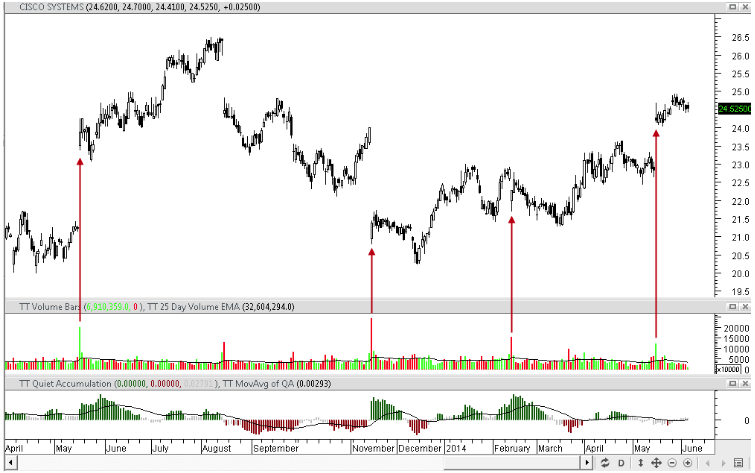The Island Gaps do fill, but the time it takes to fill the gap can be several weeks to months.
CSCO has had many island gaps form recently. Most of the gaps were caused by High Frequency Trading or HFT pre-market orders that filled the queues before the market opened, forcing market makers to set a higher or lower price for the stock at open.
Below is the original chart with arrows to show when HFTs caused the gaps. In the second chart, the islands are circled so that you can see them more easily. Not every island gap was caused by HFTs. Some were simply overnight order flow that drove price up or down before the market opened. Some are due to overseas markets’ prices that were lower or higher than the US market and so the stock price was adjusted before the market opened to the price that the stock was trading at overseas. This is done regularly to make sure all prices of stocks are the same around the world. Otherwise, if CSCO was trading lower in, say, Europe and opened higher in the US, that would create an arbitrage situation that could be exploited by many traders selling the stock in two different markets.
Island gaps reflect retail reactions to news events. Often when the retail side of the market is unaware of a problem with the company, when the news is released, HFT orders trigger huge numbers of sell orders which cause the stock to gap down due to adjustments made by market makers in response to the imbalance of sell and buy orders. Whenever there is a huge imbalance between buy and sell orders, the risk of a gap rises.
This is why it is not a good idea to use news to buy or sell stocks, and why you should not be using a recommendation service or analyst advisories. By the time you get the news, the HFTs have already moved price, often substantially, and all you are doing is chasing that stock which results too often in a loss for the retail trader.
Gaps are common nowadays due to the market structure and how news is used by HFTs. You can take advantage of HFTs IF you learn how to analyze price action before the stock gaps so you are entering before the HFTs instead of after.
If you study the chart, you will see that once a gap down or gap up occurred, the price action did not move much, and it often reversed from the gap price for a few days.
To have a profitable trade, the entry must be made prior to the gap. If you wish to learn to trade gaps, first you need to understand why, when, and how they form. Some stocks, like CSCO, gap frequently and patterns reveal the risk of a gap. Entering after a gap usually poses a higher risk of a whipsaw as profit-taking often occurs over the next couple of days.
Trade wisely,
Martha Stokes CMT
www.MarthaStokes.com
Chartered Market Technician
Member of Market Technicians Association
Master Rated Technical Analyst for Decisions Unlimited, Inc.
Instructor and Developer of TechniTrader® Stock Market Courses
Master Rated Technical Analyst for Decisions Unlimited, Inc.
Instructor and Developer of TechniTrader® Stock Market Courses
Metastock® Partner
©copyright 2014 Decisions Unlimited, Inc. All Rights Reserved.
TechniTrader is the Registered Trademark of Decisions Unlimited, Inc.
Disclaimer: All statements, whether expressed verbally or in writing are the opinions of TechniTrader its instructors and or employees, and are not to be construed as anything more than an opinion. Student/subscribers are responsible for making their own choices and decisions regarding all purchases or sales of stocks or issues. At no time is any stock or issue on any list written or sent to a student/subscriber by TechniTrader and its employees to be construed as a recommendation to buy or sell any stock or issue. TechniTrader is not a broker or an investment advisor; it is strictly an educational service.




No comments:
Post a Comment